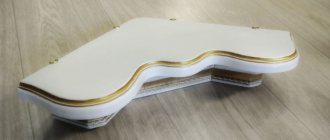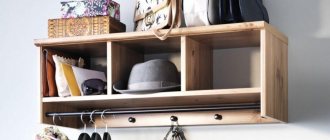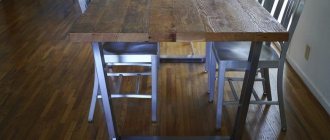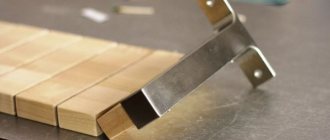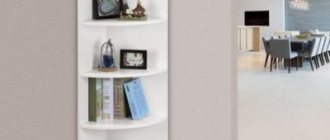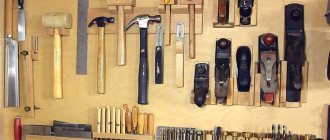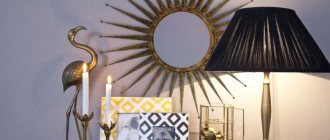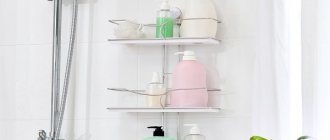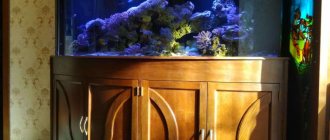Home iconostasis made of natural wood with carved patterns
The tradition of arranging a home iconostasis has existed for more than one century. Although in modern homes icons are often placed on bookcase shelves or hung on the wall, it is best to set up a separate special place for them.
Single-tier straight rack - shelf for icons
A good option would be a hanging shelf, which according to the canon should be placed on the eastern wall of the house. Often such a shelf is made corner, two or three tiers high.
Beautiful wooden shelf for icons in the corner of the room in three tiers
Corner shelf for icons with candlestick
Do you need an iconostasis at home?
Of course, believers need it, because they probably have images of various saints, but it is not always possible to allocate a worthy place for such relics. Icons most often stand in sideboards, on shelves with books, or are completely hidden in a closet. A shelf for icons is not something new and unprecedented for church parishioners. Our great-grandfathers also equipped a small prayer space in their homes. Icons were placed in the corners, decorated with embroidered towels, bouquets of dry ears of corn and flowers.
Within the access zone of any family member there were always small shrines on which miniature images and the Bible, prayer books, candles blessed in the church or bottles of water were placed. There is nothing strange in this, because in the old days people prayed every day in the morning and evening, and it was important for them to have a separate cozy corner for this, where they could concentrate entirely on communicating with God. This special place was a shelf for icons: corner, straight or icon case. Nowadays, more and more people are converting to faith, so these light traditions have become popular again.
Tradition and modernity
Even in ancient times, when the authorities persecuted Orthodox peasants for their faith, they still set up a revered place in the house for icons. It is also popularly called the “red corner”. As a rule, such a corner was located diagonally from the front door. This was done specifically so that those entering the house could immediately see the holy images, cross themselves in front of them and bow.
This place has always been treated in a special way in the house:
- It was always clean;
- They put flowers there and decorated it as best they could;
- In addition, church candles were placed there and lamps were lit if necessary.
Quite a lot of time has passed since then, but the contents of the red corner in the house have remained virtually unchanged. Holy images are still placed in it. It is also decorated with embroidered towels and both fresh and artificial flowers are placed. As mentioned above, sacred church candles and lamps are also kept next to the icons. It is also customary to store sacred oils here.
But regarding holy water, that is at the discretion of the owner. It can stand either next to the icons or in another place. The main thing is to drink it to strengthen the spirit in the morning on an empty stomach, immediately after prayer.
The best article for you, go to: Public conversations before baptism, interview before baptism
A very important point is the lamp for the home iconostasis. It should be lit during prayer, as well as on Sundays and major church holidays. Under no circumstances should photographs of famous priests, elders and righteous people be placed next to icons. From the point of view of the clergy, this is wrong. Since photography is an imprint of a person’s earthly life.
What types of shelves are there for icons?
There are two fundamental differences between the shrines. They can be straight or angular. A straight shelf for icons is hung on a flat wall; it takes up quite a lot of space, and this must be taken into account when choosing a location for it. The corner one, as the name suggests, is attached at the junction of the walls. This makes the shelf as compact as possible, but at the same time very spacious.
Iconostases also differ in the number of tiers. Shelves can consist not only of one plank - they can be two-, three- and even four-tiered. The height between the “floors” is usually different, which makes it possible to place faces of different sizes on the shrine. A shelf for icons is usually made of several types of wood: the body is made of alder or linden, and the sculptures are made of oak and ash. The color of the iconostasis directly depends on the type of material from which it is made, as well as on its outer covering.
Create your own red corner
What the home iconostasis will be like depends only on the owners of the house. However, remember to follow the following rules:
- Holy images must be installed far from technology (TV, computer, etc.) - the farther from everything worldly, the better.
- There should be enough space in front of the icons so that those praying do not feel crowded. And during prayer, it is better to place church books (prayer books, the Gospel) on a folding lectern (stand).
- You should not place icons individually on bookshelves, in cabinets, while crowding these images with other worldly objects: souvenirs, pictures, etc. This is strictly prohibited, since by doing so we show disrespect for God. After all, for some reason, many people put photographs of people we love and care about, especially those who have left this world, in the most prominent place, without cluttering them with unnecessary objects. The same should be done with icons, showing love and respect for holy images.
Where can I get the goddess?
Families whose members managed to preserve the custom of visiting churches on holidays and weekends probably retained not only a variety of ancient church attributes, but also ancient shelves for icons. A photo of one of them is shown a little higher. This shrine was made by real craftsmen several hundred years ago and clearly demonstrates the religious and cultural heritage of our ancestors. Nowadays they are no longer produced, they can only be bought from someone. But modern masters also make real masterpieces, which are in no way inferior in quality and aesthetics to their ancient counterparts.
The easiest way to buy a shrine is in specialized stores located near churches. There you can also purchase various ritual accessories made in accordance with all Orthodox canons. The corner shelf for icons is in greatest demand among believers because of its compactness, although other types also find a worthy place in the homes of parishioners.
There is another option - making a shrine according to individual parameters. This kind of work can be done by a person well versed in carpentry. The final result depends on his skill and ability, as well as on the availability of special tools for processing wood.
Design options
Orthodox canons suggest placing icons on the eastern wall. As an option, the place of the iconostasis is arranged in a corner directed to the east. Depending on the selected area, the shelf can be straight or angular. The small size of the corner shelf requires a multi-tier structure. The shelf can be equipped with a rear wall. Often it is decorated with carvings depicting birds, vegetation or the outlines of the holy apostles. The traditions of Orthodoxy do not provide for the placement of items not related to religion next to church paraphernalia. Having decided on the shape of the shelf, we move on to preparing the material and tools.
Self-production - is it possible?
In fact, a shelf for icons can be anything you want. This is not necessarily a multi-tiered product with carvings, bas-reliefs and turned balusters. As a shrine, it is quite acceptable to use the simplest wooden hanging shelf, which almost any man can carve on his own.
This product consists of guides that are attached with dowels and screws to the wall, and directly to the shelf itself. Guides are two strips with grooves connected to each other at an angle. They can be cut with a circular saw - this is the fastest and most convenient way. But if such a mechanism is not at hand, an ordinary hand saw will do. The junction of the planks with the grooves is made either smooth, then the parts are cut at the desired angle using a miter box, or studded.
The corner shelf for icons itself can be made of laminated boards, MDF or chipboard with a thickness of 12 to 20 mm. Experts recommend cutting it out not by eye, strictly maintaining a right angle in the bow part of the canvas, but by making preliminary measurements, since the walls in houses do not always meet at an angle of 90 degrees. When the required dimensions are determined, they need to be transferred to the workpiece and the shelf can be cut out using a jigsaw, after which it can be inserted into the guides.
Decoration methods
Self-made shelves for icons need finishing and decoration. This will give them a fresh and solemn look that matches the purpose of the products.
There are the following decorative options for stands for images:
- waxing;
- stain impregnation;
- varnish coating;
- adding overhead openwork details;
- artistic carving;
- engraving or burning;
- wood painting;
- applying stencils and airbrushing;
- glitter, beads and beads.
It is allowed to combine several finishing methods in one product. The main thing is that it does not look too colorful, overshadowing the image.
Wood carving
Each shelf should have a crucifix. It is made in a volumetric version by carving solid wood. In most cases, such work is entrusted to craftsmen and it is expensive. You can make an Orthodox cross yourself, using a set of well-sharpened cutters. In addition to the crucifix, relief images of domes, images of saints and martyrs, fish, birds, animals and fairy-tale characters are applied to the walls and sides. It is allowed to cut out patterns and bas-reliefs.
Execution of volumetric fragments is carried out in the following sequence:
- Selecting or making an image, transferring its outlines and small details to the workpiece.
- Sawing the part along the contour, grinding off sharp edges, removing sawdust.
- Making convex parts with cutters. This should be done in stages, with thin petals.
- Process the product with fine sandpaper. If necessary, coat it with a primer or other protective liquid.
The crucifix and overlays are glued to the back wall. To do this accurately and without distortions, you should make outlines with a pencil.
Read on our website
DIY wall shelves Making a wall shelf with your own hands is an interesting and creative activity. Everyone can be attracted to it...
Simulation process
Natural wood and good quality metal are not always at hand. Often craftsmen have to improvise to give image shelves an attractive look.
The following methods are used for this:
- Covering wood boards or plywood with adhesive film to match the color of valuable wood species, natural stone or metal. Individual pieces of film can be used to depict nature and church buildings.
- Artificial aging of wood and metal. The wood is given the appearance of an antique product by treating it with stain and steel brush. Copper and brass are soaked in salt water to create a patina.
- Adding gilding to the paint, which makes the carved domes look authentic.
How to decorate a shelf?
A corner shelf for icons often contains a variety of decorative elements and additions. If a master can make them, then his product will turn into not just a convenient and practical place for storing religious paraphernalia, but will become a worthy frame for it.
The most logical and simplest option for shelf design is carving. Craftsmen use a variety of religious symbols for carving:
- crosses;
- letter designations;
- floral ornaments;
- geometric designs.
Another method of decoration is finishing the blanks with metal plates, onto which patterns are applied using a special embossing technique (basma). Making such decor yourself is very problematic. Most often, the basis for basma is a straight shelf for icons. Corner iconostases are also decorated in this way, but selectively and only in small fragments.
Differences between corner shelves, their sizes
There are several options for such iconostases. They differ in height, design and additional attributes. A standard corner shelf for icons is 63 cm wide and 33 cm deep. The height directly depends on the number of tiers in the product and its decor.
Usually shrines are open to view, but there are models equipped with small drawers. You can store miniature objects in them, such as crosses or small icons inlaid with precious metals. There are also completely closing iconostases, the shelves of which are hidden behind hinged doors.
The right place for privacy
Where is the best place to place the shrine? A straight shelf for icons will not fit into every interior, because it will catch the eye of everyone in the room. If there is not much space in the house and its owner does not have the opportunity to allocate a separate room for prayers, it is better to opt for a corner iconostasis. You can hang it in the bedroom, living room and even in the kitchen, because people often pray before eating. The shelf itself is attached high enough, but not right under the ceiling, but so that you can easily take something from it.
History of the red corner
Every person has heard the phrase “red corner” or “God’s place”. However, not everyone knows why this place received such a name and how correctly it was located. You can often hear the answer that this is the right corner from the door. But it is not always the case.
Ethnographers claim that in past times, “God’s place” was located diagonally from the stove.
And this was done for a reason. The word red was associated with spring, summer and warmth, so they tried to place icons more on the south or east side.
The north and west for the ancient Slavs were comparable to death, evil spirits and severe winter. A little later, these stereotypes diverged, and people began to simply create cozy corners with numerous icons.
